How to Measure PR Performance? [2026]
Table of contents
For Mental Health Awareness Week, McDonald’s researched that 48% of British children feel pressure to be happy all the time (even if they do not want to be). As a result, the company has removed its iconic smile from 2.5 million Happy Meal boxes in the UK for the first time ever. Instead, they included stickers to make children show what their real feelings are at the moment. This brilliant campaign significantly increased McDonald’s brand mentions, positive sentiment, and boosted its PR performance.
PR performance indicates how effective and impactful your public relations actions are in achieving your desired goals. Positive PR performance occurs when your efforts increase your brand visibility, brand awareness, positive reputation, and media coverage across multiple sources.
What is PR performance?
PR performance is a process of checking how well your public relations activities meet the goals you previously set.
What goals do I have in mind?
Typical objectives of public relations activities are improving brand reputation, increasing visibility, driving positive media coverage, influencing public perception, and enhancing communication with the industry and key stakeholders.
Measuring PR performance is necessary to:
- Rate your PR campaign’s success because it shows how well it met the anticipated goals and objectives.
- Learn from your mistakes because concrete data shows what didn’t work and helps improve future strategies.
- Prove Return on Investment because PR efforts must have tangible business outcomes.
- Understand public sentiment because it reveals how people feel about your brand and shapes your communication strategy.
- Manage crisis response because it improves your actions during a crisis and helps adjust future responses.
Check your PR performance now!
How to measure PR performance?
To measure PR, you need to track:
- Media Impressions & Media reach
- Share of voice (SOV)
- Sentiment analysis
- Website traffic from PR efforts
- Backlinks
- Social media reach
- Presence Score
- Return on Investment (ROI)
01 Media impressions & 02 Media coverage
Media impressions and media coverage are mutually interrelated. Therefore, I decided to explain them together.
All your PR efforts are about one – making some (preferably positive) noise!
Hence, the first PR performance metric you should focus on is media impressions.
Simply put, media impressions refer to the number of times your target audience had contact with your PR message.
Media coverage is like the flip side of media impressions. It indicates the number of times your brand or campaign appears in the media.
Let’s underline the difference:
- Media impressions indicate the potential number of people who may have had contact with your brand or PR campaign.
- Media coverage indicates the actual number of mentions in media outlets about your brand or PR campaign.
So, media coverage shows much more realistic figures. It’s way easier to track media mentions that are publicly available. All you need to have is an appropriate media monitoring tool like Brand24.
Brand24 gathers both social & non-social brand mentions. But if you want to focus solely on regular media outlets, you can easily filter social platforms.
If you need a more detailed approach (e.g., to check your PR campaign’s media coverage), you can adjust the results using related keywords.
Blah, blah, blah.
Let’s do it in practice and check the media coverage of McDonald’s latest PR campaign!

As I described at the beginning of this article, British McDonald’s created a campaign for 2024 Mental Health Awareness Week (May 13 – 19th).
To discover this campaign’s media coverage, I needed to apply some filters to Brand24:
- The dates range between 13 to 19th May;
- Mentions sources limited to news, blogs, and the web;
- Only mentions including keyphrases “Mental Health Awareness Week” or “It’s okay not to be happy all the time” (which identifies the campaign)
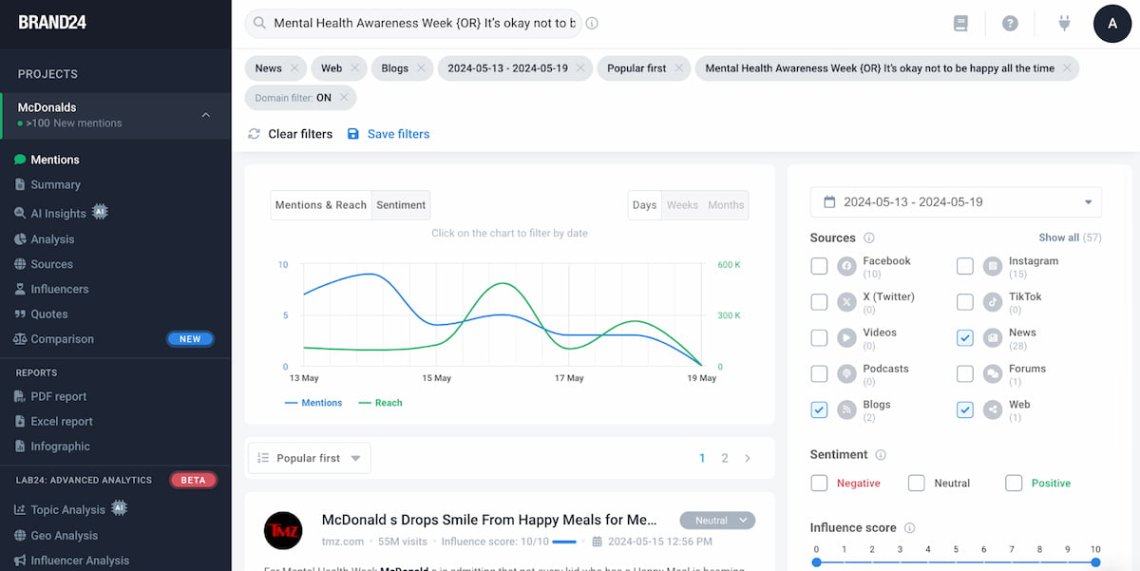
The results?
As for media coverage, McDonald’s PR campaign was published in 31 different media outlets. Most of them are from the UK. Not surprising at all, as it was an initiative of British McDonald’s.
Regarding media impressions, it looks even more – ahem – impressive.
According to Brand24, nearly 1,2 million people could have seen the McDonald’s campaign in non-social sources only. These include news sites, blogs, and other websites.
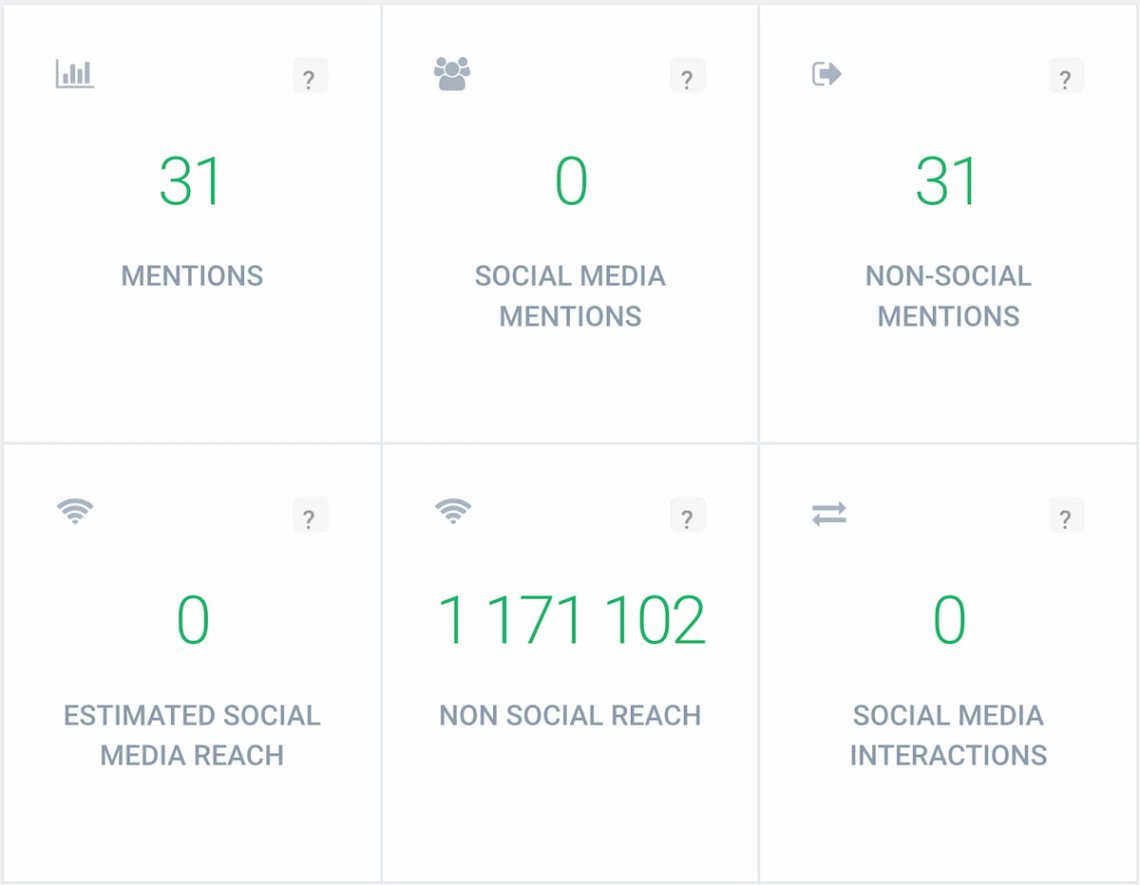
I don’t know if these figures are satisfying enough for McDonald’s. I just don’t have access to the company’s KPIs and OKRs to say: “Guys, great job!” or “We screwed it”.
But I really like this campaign. It’s thoughtful, smart, and well-designed. I hope the results meet McDonald’s expectations!
For more inspiration and examples of successful campaigns, you can also check out some of the best PR campaigns.
03 Share of voice (SOV)
Share of voice (SOV) is the third metric you should track to know your overall PR performance.
It measures how much media coverage your brand receives compared to your competitors, benchmarks your social media presence, and gives an overview of your overall brand visibility.
The important thing is that share of voice exists only when you have a reference point.
In other words, to define your brand’s share of voice, you must place it side by side with your competitors’ share of voice.
Okay, but how to measure it?
I checked many tactics, and my conclusion is that to discover your SOV quickly and accurately, you should use an AI-powered media monitoring tool like Brand24.
This software is like a black-belted karate master.
For more than 12 years, Brand24 lived in the wild, practicing social listening punches and media monitoring kicks.
Bruce Lee once said: „I fear not the men who has practiced 10,000 kicks once, but I fear the man who has practiced one kick 10,000 times”.
That’s how Brand24 reached mastery in the media monitoring martial arts!
Fine, let’s set karate metaphors apart.
Brand24 is great because it identifies, tracks & analyzes all your brand mentions shared on the internet. Based on them, the tool is able to provide you with a real-time share of voice.
In practice, just go to the Comparison Tab and set the project to compare.
McDonald’s main rivals are KFC and Burger King. So, let’s check their SOV in the industry.
Obviously, the Golden Arches has twice as much share of voice as KFC & Burger King combined.
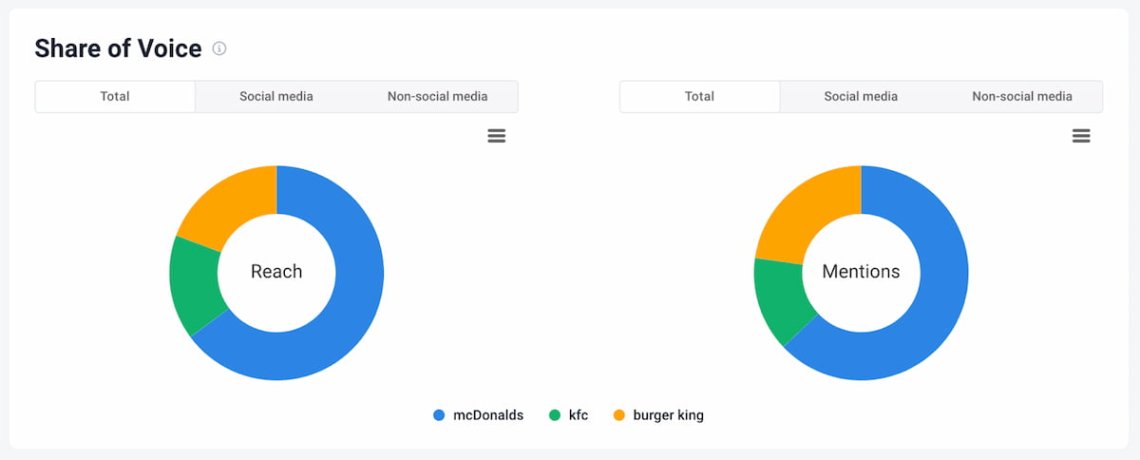
04 Sentiment analysis
All right, it’s time for a PR performance metric of a different type.
Media Impressions and SOV are quantitive PR performance metrics – they answer the question „how much?”.
Sentiment analysis is a quality metric, diving deeper into the reception of your message. It answers the question „how do people feel about my brand/PR campaign?”.
The emotions towards you can be positive, negative, or neutral.
Thanks to measuring PR sentiment, you will find out:
- What resonates with your audience positively and negatively;
- How people perceive your latest PR campaign performance;
- Which topics are trending in your industry.
Monitoring the sentiment is possible with the use of appropriate tools.
Brand24 not only detects your brand mentions, but it also does an automated analysis of each mention’s emotional tone.
The tool’s algorithm recognizes sentiment-related words used around brand mentions.
For example, if someone types „I love french fries from McDonald’s!”, Brand24 automatically assigns it as a positive brand mention.
You can check your brand’s present reception by opening the Sentiment chart in the Mentions Tab.
As you can see below, McDonald’s enjoys a stable trend of positive sentiment outweighing the negative one.
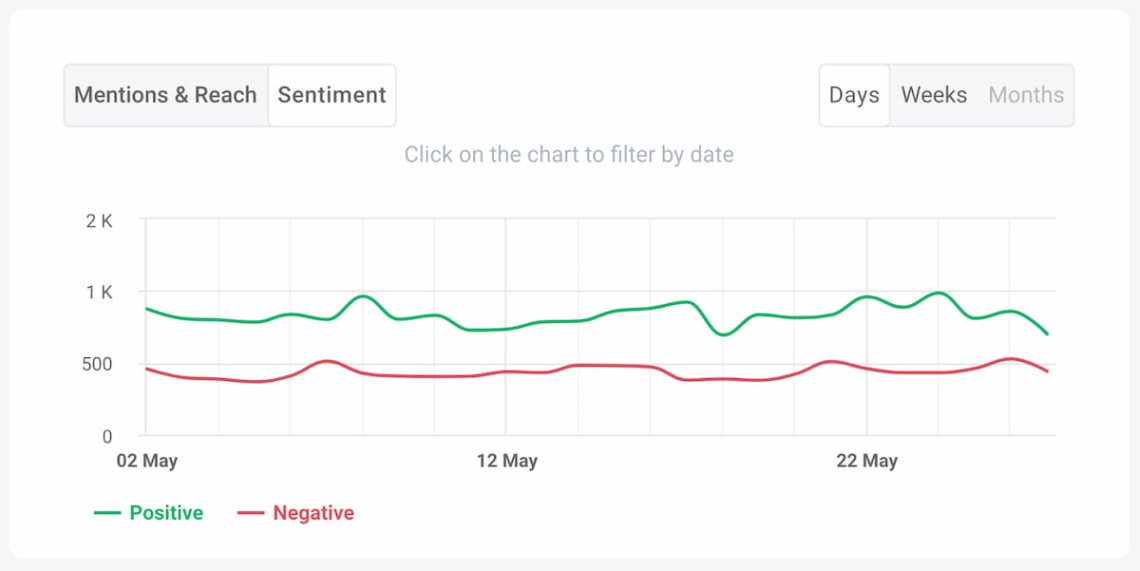
Moreover, Brand24 allows you to delve deeper into emotions toward your brand or campaign. Just visit the AI Metrics Analysis.
This tab gathers a lot of super useful information, such as a detailed sentiment analysis divided into six major feelings: disgust, admiration, joy, sadness, anger, and fear.
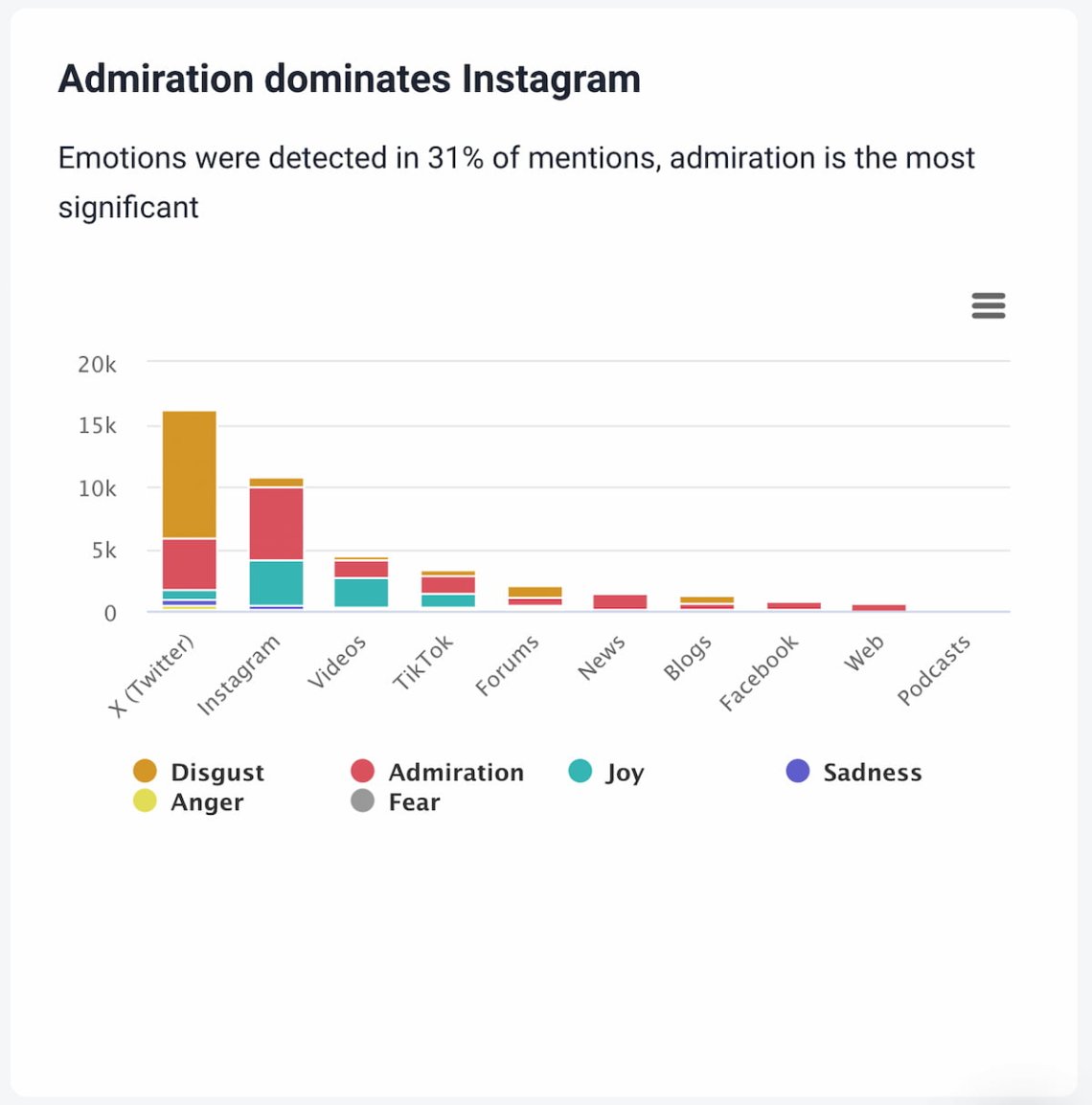
You can also discover which source of mentions brings you the most negativity.
In the case of McDonald’s, X (Twitter) is a real den of vipers. Hisssssssssss!
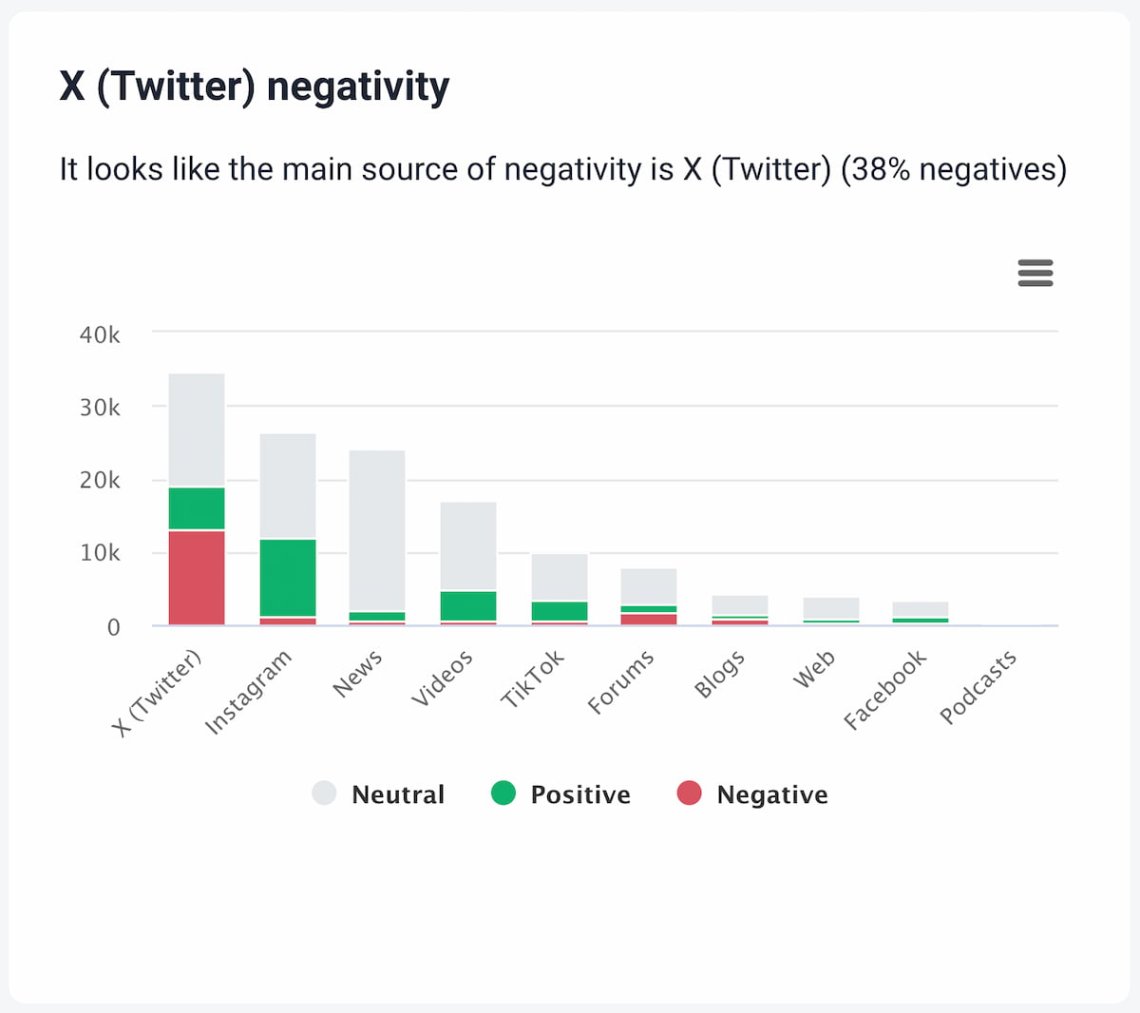
For a deeper dive into PR sentiment and how to measure it effectively, check out our full guide on PR Sentiment Analysis.
Discover who loves & hates you!
05 Website traffic from PR efforts
It is true that public relations aims to build your brand visibility and brand awareness. But these are not the only goals!
PR efforts should also bring some business value. In other words, they should drive traffic to your website.
Attracting people to your website is crucial, particularly if you’re a SaaS company or e-commerce store. Driving more traffic can lead to higher conversions.
Even if you’re selling offline (like McDonald’s), higher website traffic can help people learn about your products or services and potentially convert them into leads or sales.
All right, but how could you measure how much website traffic your PR efforts drive?
The best way is to combine UTM Parameters and Google Analytics.
UTM (Urchin Tracking Module) codes are small pieces of text added to the end of a URL that helps track the effectiveness of your campaigns.
Simply put, they allow you to see where your website traffic is coming from. There are three basic UTM parameters:
- utm_source, i.e. Washington Post
- utm_medium, i.e. news
- utm_campaign, i.e. Not So Happy Meal
In that case, your URL could look the following:
http://mcdonalds.com/big_tasty_burger?utm_source=washingtonpost&utm_medium=news&utm_campaign=not_so_happy_meal
Once you’ve implemented UTM parameters in your campaign URLs, visit your Google Analytics account to track the traffic driven by your PR efforts.
Go to the “Acquisition” tab and select “Campaigns” to view your campaign’s PR performance.
Here, you can analyze metrics such as the number of sessions, bounce rate, and conversion rates for each UTM-tagged URL.
This data will help you evaluate the effectiveness of your PR efforts in driving website traffic and achieving business goals.
06 Backlinks
Backlinks are pretty self-explanatory. These are external links that lead to your website from other websites.
They serve various SEO & PR goals:
- Improve search positions, as backlinks are still one of the most important ranking factors;
- Upgrade your Domain Authority so that in the “eyes” of search engines, your domain appears as a more trusted source;
- Drive traffic from the referring site to your website;
- Increase your visibility & credibility.
The keyword here is “quality”.
In general, it’s better to focus on earning backlinks from high-traffic and authoritative sites rather than striving to get as much as possible.
Whereas good quality links can significantly boost your SEO & PR performance, a poor backlink profile and performing illegal tactics (i.e., buying links) can seriously damage your domain’s reputation.
As for monitoring backlinks, you should use one of the professional SEO tools: Semrush, Ahrefs, or MOZ.
At first glance, they seem a bit complicated. But when you familiarize yourself with their dashboards, you’ll understand why most marketers can’t imagine their everyday work without such tools.
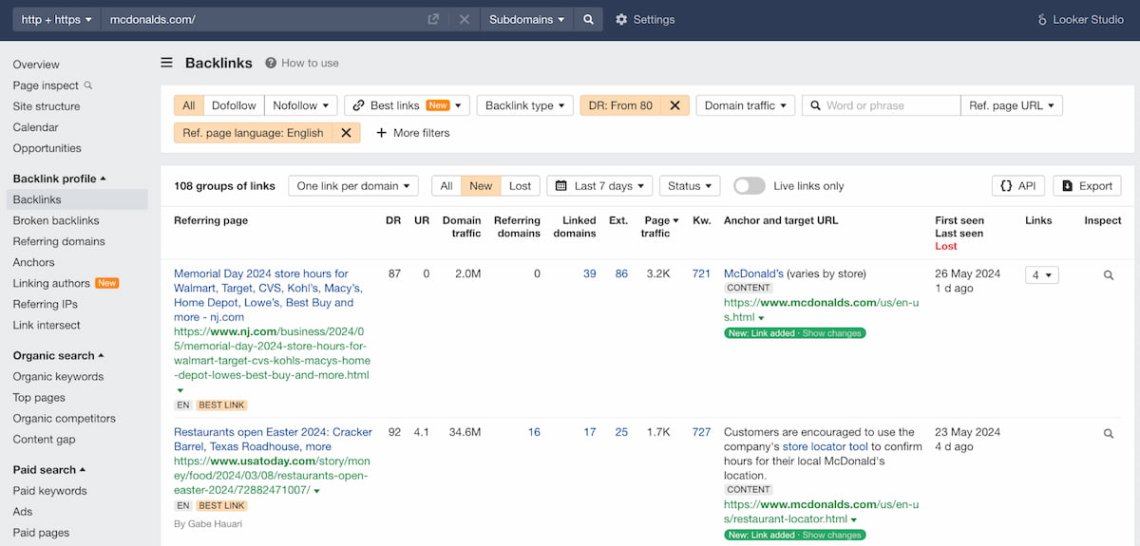
07 Social media reach
We have focused on non-social PR performance metrics until now. But as you surely know, social media are absolutely essential for spreading your message.
Therefore, to have a broader picture of your PR performance, you should measure your social media reach.
In short, the social media reach is an estimated number of users who might have seen your PR campaign on social media platforms.
Now, we must answer the crucial question: how to measure social media reach?
You can do it two ways:
- Native analytics solutions.
All major social media platforms offer their own analytics tools.
The biggest advantage of such a solution is that the data are accurate.
However, there is one problem: if you use multiple social platforms, using separate analytics tools is a very time-consuming task. - A single social listening tool like Brand24.
Using one tool, you can reduce the time spent on measuring your PR performance separately.
Brand24 tracks & analyzes mentions from Facebook, Instagram, TikTok, X (Twitter), LinkedIn, Reddit, Twitch, and Telegram.
If you’re not sure if measuring social media reach is necessary, let me show you something.
This is the number of people who could’ve seen a McDonald’s-related social media post in just 30 days.
Almost 790 million people!
Just wow.

Check your PR performance now!
08 Presence Score
Okay, and what if you’d like to overview your PR performance without getting so much into details? Is there any way to take a look from a bird’s eye view?
Of course! There are even two ways to do it!
The first is the Presence Score. It’s a handy numerical metric that shows your online exposure and helps to understand the popularity of your brand or PR campaign performance at the given time.
In practice, the Presence Score ranges from 0 (lack of exposure) to 100 (everyone knows you). The more mentions and reach, the higher your Presence Score.
To discover your Presence Score, just go to Brand24’s Analysis tab and scroll down.
Thanks to measuring Presence Score, you will find out:
- How visible is your brand compared to your competitors;
- If your current PR strategy is fruitful or not;
- How has your latest PR campaign impacted your overall online exposure.

09 Return on Investment (ROI)
Measuring your PR performance won’t be complete without a Return on Investment (ROI). Because no matter how creative and smart your campaign is, you need to drive tangible financial results.
In short, ROI measures the economic impact of your investment. It helps discover the real profitability and efficiency of a particular investment.
The formula is extremely simple: ROI = Net Profit/Total Costs x 100%
Okay, the formula is simple. In general, it’s pretty easy to calculate total costs. The real challenge is to assign a monetary value to your PR actions.
That’s why we have all the abovementioned PR performance metrics!
By tracking things like media impressions, social media reach, and website traffic with UTM parameters, you can determine (or at least estimate) the real value of your PR efforts.
Check your PR performance now!
Conclusion
Measuring your PR performance is indisputably crucial.
You can picture it as an anchor holding your ship steady. Without it, you’re swimming with the flow, unsure if your efforts are effective or just drifting with no purpose.
Because PR is not art for art’s sake. Right, you must be creative and innovative to break through the ocean of information.
But in the end, it’s the effectiveness of your actions that counts.
By tracking key PR measurements like media impressions & coverage, share of voice, sentiment analysis, or ROI, you can see the real impact of your efforts.
Just like a skilled captain uses navigational tools to steer the ship, these metrics guide you toward better outcomes. Ah, and don’t forget about the appropriate public relations software.
Final thoughts:
- Tracking your PR performance regularly helps you to identify which campaigns drive the most brand mentions and positive sentiment.
- Using media monitoring tools like Brand24 makes measuring your PR performance quick & effortless.
- Measuring website traffic with UTM parameters is crucial to discovering if your PR efforts convert into visits and sales.
- If you need a bird’ s-eye view of your PR performance, check your Presence Score and Reputation Score.
Are you ready to measure your PR performance like a pro? Try Brand24 for free!



